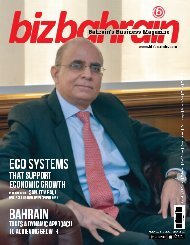You also want an ePaper? Increase the reach of your titles
YUMPU automatically turns print PDFs into web optimized ePapers that Google loves.
Focus Feature | Economy Review <strong>2018</strong><br />
<strong>2018</strong> OUTLOOK<br />
Bahrain Economy Upbeat<br />
by Reena Abraham<br />
Bahrain’s economic outlook for <strong>2018</strong><br />
stands on positive ground with a<br />
resilient non-oil sector expected to keep<br />
overall growth at stable levels. A steady<br />
pace of around 3% overall growth in <strong>2018</strong><br />
and 2019 is anticipated and will balance<br />
and offset any frailty in the oil sector.<br />
In its latest update on Bahrain’s<br />
economy, National Bank of Kuwait (NBK)<br />
reports that the Oil sector output for <strong>2018</strong><br />
is set on a flat horizontal due to Bahrain’s<br />
partaking in the OPEC/non-OPEC oil<br />
production cut deal, now extended to<br />
the end of <strong>2018</strong>. However budget deficit<br />
is expected to gradually narrow given<br />
ongoing fiscal consolidation efforts as<br />
well as improvement in revenues. In<br />
2019 oil activity is predicted to pick up<br />
and grow by 1.4% as the production deal<br />
unwinds on the back of a new 350,000<br />
b/d offshore oil pipeline connecting<br />
to neighboring Saudi Arabia. The new<br />
pipeline is part of Bahrain’s plans to<br />
expand its refinery capacity. It will<br />
replace the 230,000 b/d pipeline, which<br />
the government-run Bahrain Petroleum<br />
Company was forced to temporarily close<br />
in November 2017 though production was<br />
restored within a couple of days.<br />
Growth from infrastructure<br />
investments increased and the financial<br />
stability of the Kingdom has been<br />
observed in the last 4 Quarters and these<br />
positive indicators reflect government’s<br />
efforts to enhance the national economy<br />
which faces challenges at the local,<br />
regional and international levels.<br />
Bahrain is looking into expanding<br />
output from its domestic field by tapping<br />
into unconventional gas. To expand its<br />
energy mix, the nation is building its<br />
first liquefied natural gas (LNG) terminal,<br />
expected to be completed in 2019 which<br />
will allow the import of up to 0.8 billion<br />
cubic feet of gas per day for domestic use.<br />
Saudi Aramco could link up the terminal<br />
with other GCC countries. This would in<br />
effect turn Bahrain into a hub for LNG<br />
imports for the region.<br />
Over the past few quarters<br />
infrastructure spending has been<br />
bolstered by the allocation of funds<br />
under the Gulf Development Program - a<br />
pledge by Bahrain’s neighbors in 2011 to<br />
provide $10bn in grants over 10 years to<br />
boost investment in infrastructure and<br />
housing. Data from MEED pointed to an<br />
impressive 20% y/y increase in executed<br />
projects in October 2017. Key areas of<br />
project activity include the aluminium<br />
sector, airport expansion, social housing,<br />
utilities, roads, renewable energy and<br />
telecoms. There are also plans for a<br />
second causeway linking Bahrain and<br />
Saudi Arabia, connecting Bahrain to the<br />
GCC rail network.<br />
Non-oil growth has also been<br />
supported by healthier gains in the<br />
financial services sector, which averaged<br />
at an impressive 6.4% y/y over the first<br />
three quarters of 2017, much higher<br />
than the 3.6% y/y average recorded<br />
during the same period in 2016. Similar<br />
trends are being witnessed across most<br />
other non-oil sub-sectors, including<br />
the transportation & communications<br />
and social & personal services sectors,<br />
which were up an average 7.7% y/y<br />
and 11.6% y/y, respectively, during the<br />
same period. Growth in manufacturing<br />
activity was more muted in 2017 due to<br />
some production disruptions at the Alba<br />
aluminium smelter (one of the largest<br />
in the world). With these disruptions<br />
resolved, growth in manufacturing<br />
activity should recover in the near-tomedium<br />
term. The pace of employment<br />
growth has been strong if volatile since<br />
2H14, helped by solid economic growth<br />
including a pickup in activity in the<br />
construction sector.<br />
Consumer price inflation is expected<br />
to rise in <strong>2018</strong>, mainly on the back of a<br />
12 January-February <strong>2018</strong>

















